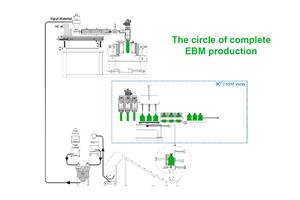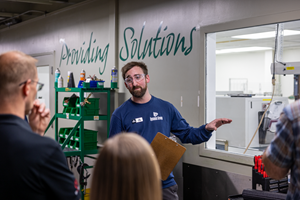'Mega-Trends' Driving Polyolefins Developments at Nova Chemicals
Sustainability, e-commerce, application development and time to market are just some of the over-arching trends driving PE and PP development.
Nova Chemicals’ development work in polyolefins in increasingly being influenced by major market trends reshaping the consumer experience. “We are focusing on packaging and other solutions, and how our products provide the required performance properties for today’s most important applications,” says Mark Kay, performance films group leader at Nova Chemicals. Representatives of the company are in Room W207AB at NPE2018.
Mega trends as defined by Nova include:
Sustainability: New PE resins and other recent innovations are enabling multilayer moisture and moisture-plus-oxygen-barrier food packaging to move from multi-material, non-recyclable structures to recycling-stream-compliant structures. “We are exhibiting physical samples and information to help film producers and converters learn more about how they can produce these types of recyclable structures and packaging,” Kay says.
Shifting demographics and consumer preferences are driving the demand for more sustainable solutions in packaging and beyond. Negative publicity around plastic gyres in the ocean and beaches strewn with plastics only adds to the urgency to lightweight products; increase recyclability; boost curbside collection; enhance sorting capabilities; and innovate to increase the demand for recycled materials, according to Nova Chemicals.
Major retailers and brand owners are working towards goals around all reusable, recyclable, or compostable packaging, and these initiatives are speeding the shift to recyclable packaging. There is also a significant push towards sustainable solutions by the packaging companies themselves.
Examples include conversion from rigid to flexible packaging. Now, new resins and structure design are making recyclable flexible barrier packaging a reality, and Nova says it’s seeing the development of new types of pouch fitments to further support new flexible applications. “We’re also seeing new legislation drive innovation to allow for tethered caps and closures to ensure that they enter the recycle stream properly,” Kay says. Another example is the continued switch in beverage caps and closures from two-piece to one-piece construction, improving manufacturing efficiency and closure recyclability.
E-commerce: “We are working with film producers, package makers, and brand owners to develop food packaging with the durability (stiffness/toughness balance) and other properties that are required for the rigors of the e-commerce supply chain,” Kay says. “We have an exhibit here with information about the supply chain requirements, and the work we’re doing in the value chain to help improve packaging for this fast-growing segment.”
The consumer of today is very different than the consumer of 20 years ago, according to Nova. “The younger generations typical lifestyle is busier and busier, and at the same time, they’re looking for healthier options, which often require performance packaging,” Kay explains. “Everyone is on the go and these buyers want the products they consume to be delivered quickly, consumed easily, and disposed of efficiently.”
E-commerce is a game-changing example of the convenience trend, and its efficiencies coupled with the ease of comparison shopping are also driving down prices in many sectors. As Business Insider reports, E-commerce is driving virtually all retail growth, and its impact on flexible packaging will grow with it. According to the Food Marketing Institute, the online grocery market alone may reach $100 billion by 2022. Better performing flexible packaging solutions, especially seal integrity and abuse resistance so products arrive at the consumer’s door intact, will be a must to support the more rigorous e-commerce supply chain.
Rigid industrial packaging like drums and intermediate bulk containers (IBCs) may be utilized to ship goods in bulk to online sellers, who will then repackage the goods into smaller packages for customer orders.
Computer Modeling/Application Development: Nova Chemicals points out that modeling technologies are a powerful tool to speed the product development cycle and reduce both cost and material usage in the process. “We are demonstrating our proprietary Bonfire tool for modeling flexible film structures online and our customized caps computer modeling tool in our suite,” Kay notes.
Nova is also highlighting its Centre for Performance Applications, which opened in 2016 after an expansion. “We help customers develop new products and applications at this facility in Calgary that offers blown and cast film production capabilities, a range of rigid and flexible converting equipment, and laboratory test capabilities, all under one roof,” Kay says.
“One of the biggest challenges we see moving forward is the ability to innovate at the rate required to keep up with rapidly evolving ´óĎó´«Ă˝ models and market demands,” Kay says. “However, there are many technologies on the market including 3D printing, fluid dynamics, and computer-aided modeling that enable rapid prototyping to help shorten product development timelines.”
Kay notes that success can only come if the entire supply chain collaborates with answers for all of the mega trends. “If a material supplier focuses only on consumer convenience packaging challenges, then quite likely key design decisions like lightweighting, recyclability and packaging line speeds and efficiencies get lost in the equation,” Kay says.
Nova is also emphasizing recent expansions, acquisitions and joint ventures, including: the PE1 plant expansion where approximately 1 billion lb of butene LLDPE resin started up in December 2016; acquisition of a Geismer, Louisiana ethylene plant from Williams Partners in 2017; the AST2 plant build with additional capacity of octene LLDPE in Sarnia, Ontario; and the Novealis joint venture with Total Petrochemicals, including a new ethane cracker in Port Arthur, Texas; new PE unit in Bayport, Texas, as well as the existing Total PE unit in Bayport, with start-up expected in late 2020.
Related Content
Get Color Changes Right In Extrusion Blow Molding
Follow these best practices to minimize loss of time, material and labor during color changes in molding containers from bottles to jerrycans. The authors explore what this means for each step of the process, from raw-material infeed to handling and reprocessing tails and trim.
Read MoreMedical Molder, Moldmaker Embraces Continuous Improvement
True to the adjective in its name, Dynamic Group has been characterized by constant change, activity and progress over its nearly five decades as a medical molder and moldmaker.
Read MoreMultilayer Solutions to Challenges in Blow Molding with PCR
For extrusion blow molders, challenges of price and availability of postconsumer recycled resins can be addressed with a variety of multilayer technologies, which also offer solutions to issues with color, processability, mechanical properties and chemical migration in PCR materials.
Read MoreMedical Tubing: Use Simulation to Troubleshoot, Optimize Processing & Dies
Extrusion simulations can be useful in anticipating issues and running “what-if” scenarios to size extruders and design dies for extrusion projects. It should be used at early stages of any project to avoid trial and error and remaking tooling.
Read MoreRead Next
Making the Circular Economy a Reality
Driven by brand owner demands and new worldwide legislation, the entire supply chain is working toward the shift to circularity, with some evidence the circular economy has already begun.
Read MoreFor PLASTICS' CEO Seaholm, NPE to Shine Light on Sustainability Successes
With advocacy, communication and sustainability as three main pillars, Seaholm leads a trade association to NPE that ‘is more active today than we have ever been.’
Read More










